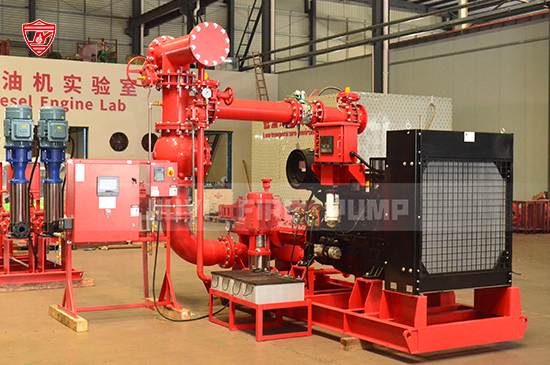In any fire protection system, the fire pump plays a crucial role in ensuring water is delivered with sufficient pressure to extinguish fires effectively. To guarantee reliable performance, routine fire pump flow testing is essential. For this reason, understanding fire pump flow testing equipment is critical for facility managers, fire protection engineers, and safety compliance officers.
This article provides a comprehensive overview of the types of flow testing equipment used, key testing procedures, standards like NFPA 25, and expert tips for maintaining compliance and performance.

Fire pump flow testing is the process of evaluating the operational performance of a fire pump to ensure it meets design specifications. This testing simulates real fire conditions by running the pump and measuring output at various flow levels.
The objective is to verify that the pump can deliver water at the required pressure and flow rates under varying demand conditions, and that it's functioning as expected per NFPA 25: Standard for the Inspection, Testing, and Maintenance of Water-Based Fire Protection Systems.
Regulatory Compliance: NFPA 25 mandates annual flow testing for fire pumps to ensure readiness in emergencies.
Early Detection of Issues: Testing helps identify issues like impeller wear, blockages, or valve failures before they lead to system failure.
Insurance and Liability: Insurers often require documented pump performance testing for coverage validity.
Public Safety: Ensures that fire protection systems function optimally to protect lives and property.
Various types of equipment are used to conduct accurate and efficient fire pump flow tests. Below are the most commonly used:
A flow meter measures the volume of water moving through a pipe during the test.
Types: Paddlewheel, ultrasonic, electromagnetic, and pitot tube.
Use: Installed on a test header or discharge piping.
Benefits: Digital flow meters provide real-time data and can store historical performance records.
A traditional tool that measures nozzle pressure from a hose stream to calculate flow.
Use: Applied at test header outlets.
Calculation: Flow (GPM) = 29.84 × √Pitot Pressure × Nozzle Coefficient².
Best For: Facilities with limited instrumentation.
Pressure gauges are critical for measuring static, residual, and churn (no-flow) pressure.
Installation Points: Suction, discharge, and casing relief valve lines.
Function: Indicates system pressure under different flow conditions.
These are manifolds connected to the fire pump discharge side, fitted with multiple outlets for hose connections.
Purpose: Simulate system demand by flowing water outside the building.
Important: Must be sized properly to handle 150% of pump rated flow.
Hose Monsters or flow diffusers allow for safe and accurate flow testing through fire hoses.
Features: Integrated with flow measurement devices.
Advantage: Controls water discharge safely in limited space areas.
Here is a typical outline of the fire pump flow test process, based on NFPA 25:
Inspect all valves (suction, discharge, and isolation).
Check pump casing and piping for visible damage or leaks.
Verify pressure gauge calibration.
Start the pump with all test valves closed.
Record suction and discharge pressures.
Listen for abnormal noises or vibrations.
Open valves to simulate design flow.
Record pressure readings and flow rate.
Check that pump maintains proper pressure at rated flow.
Further open outlets to increase demand.
Pump must maintain at least 65% of rated pressure.
Record all relevant data.
Compare data to manufacturer curves.
Note any performance deterioration.
Document results for compliance and maintenance planning.
NFPA 25 mandates annual fire pump flow testing for both electric and diesel engine pumps. According to the standard:
Annual Test: Full flow test at no flow, rated flow, and 150% of rated flow.
Monthly Test: Electric pumps require a no-flow test run for at least 10 minutes.
Diesel Pumps: Require a longer test duration (30 minutes) and fuel system inspection.
Failure to comply can result in code violations, increased liability, or insurance claims denial.
When selecting flow testing equipment, consider:
Accuracy Requirements: Ultrasonic or magnetic flow meters offer high precision.
Test Frequency: Facilities doing frequent tests may invest in permanent flow meters.
Water Disposal Options: In urban or tight spaces, Hose Monsters help avoid flooding.
Budget: Mechanical pitot gauges are cost-effective but labor-intensive.
| Challenge | Solution |
|---|---|
| Inaccurate readings | Calibrate flow meters and pressure gauges regularly |
| Inadequate drainage | Use diffusers or tanks to manage water flow |
| Lack of documentation | Use digital meters with data logging |
| Restricted space | Install permanent flow meters with remote display |
Always follow the pump manufacturer’s curve for comparison.
Train staff on equipment handling and test procedure.
Keep accurate and accessible test records.
Partner with certified fire protection professionals for third-party verification.
With advancements in technology, the fire safety industry is seeing innovations like:
Wireless Flow Meters: Transmit data in real-time to cloud dashboards.
Integrated Test Panels: Combine pressure and flow sensors with alarms.
Remote Monitoring Tools: Alert facility managers when performance drops.
These tools enhance testing accuracy, reduce human error, and improve data analysis.
Fire pump flow testing is not just a compliance task—it's a critical safety measure that protects lives and assets. By understanding and selecting the right fire pump flow testing equipment, you can ensure system reliability, maintain regulatory compliance, and avoid costly failures.
Whether you are using a basic pitot gauge or an advanced ultrasonic meter, the key is consistent and accurate testing performed in accordance with NFPA 25 standards.